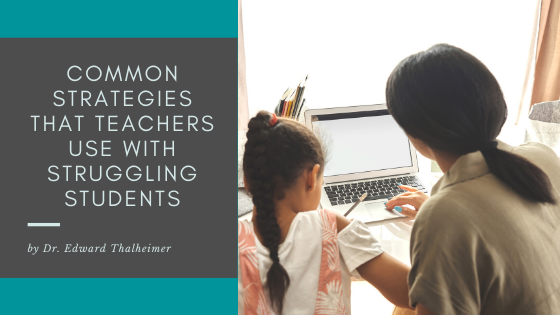For many students, knowing how to study effectively, how to process the material presented in the classroom, and knowing how to apply knowledge in new contexts is a challenging task. While most parents of struggling students believe that their children will set themselves up for success if they work hard, help from their teachers is sometimes required. On that premise, the following article presents the most common strategies that teachers use to aid struggling students.
The differentiated instruction approach
Differentiated instruction is a student-centered approach to learning. When teachers take a differentiated approach to instruction to address student needs, it involves:
- Assessing what skills/concepts each student needs to attain (this may be different for different students)
- Adapting either how the skills or materials are presented or how students will demonstrate their understanding of the concept.
Such an approach allows students who understand or are advanced in one aspect of a concept to focus on what they still need to learn while their classmates may be focusing on a different skill or concept.
The scaffolding approach
With the scaffolding approach, the teacher breaks the material down into chunks. These chunks should have a logical order that moves towards a clear objective. The teacher also forms a bridge between what their students already know and what they are learning. These bridges are called scaffolds and can include pictures, charts, and cue cards. Their lessons will likely involve opportunities for students to work alongside the teacher as a guide and then progress to completing the task independently as they gain confidence in their abilities.
The mnemonics approach
The mnemonics approach denotes utilizing memorable phrases, acronyms, or abbreviations to remember specific information more easily. An example of a mnemonic device would be using “Roy G Biv” to remember the order of the colors in the rainbow (Red, Orange, Yellow, Green, Blue, Indigo, & Violet). Another would be “Pretty Please My Dear Aunt Sally” to remember the mathematical order of operations (Parentheses, Powers, Multiplication, Division, Addition, & Subtraction.)This method can also aid students in learning vocabulary more quickly.
The multisensory instruction approach
The multisensory instruction approach denotes linking what the students hear, what they see, how they feel, and how they move. Students often have an easier time remembering information delivered in ways that use multiple senses in the process. This is why lab experiments, visual aids, and music can be excellent ways to engage students and boost their ability to retain what they’ve learned.
While not all teachers use each of these methods, it can help parents understand the various approaches. If your child struggles with particular concepts or skills, it’s a good idea to reach out to your child’s teacher and work with them to determine the best way to help your child succeed.
Dr. Edward S. Thalheimer is the President and Founder of The Tutoring Franchise Corp. For our part, we here at The Tutoring Center® are continuing to provide one-to-one instruction combined with The Rotational Approach to Learning® to prevent children from slipping through the cracks academically. Our programs help children achieve long-term success, build concentration and focus, and, with our outstanding instructors, find the love of learning. Don’t let your child fall behind this school year. If you’re interested in learning more, visit our website at TutoringCenter.com.
